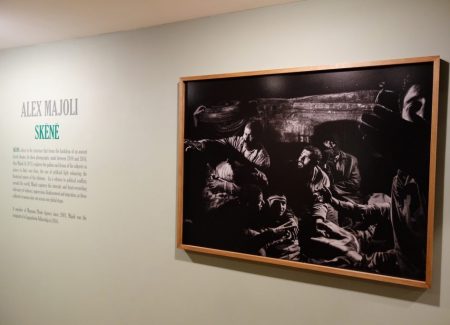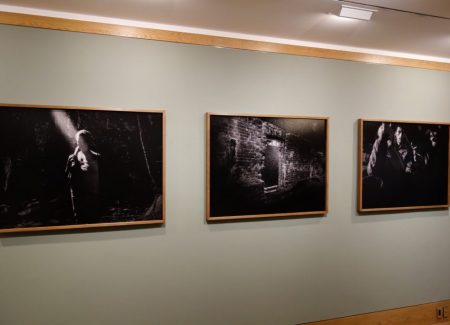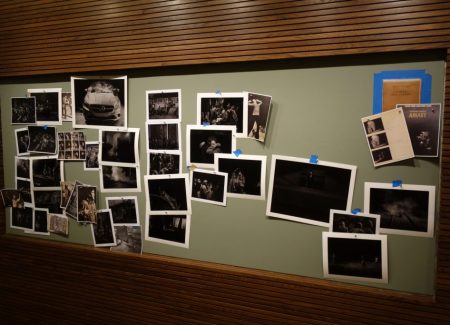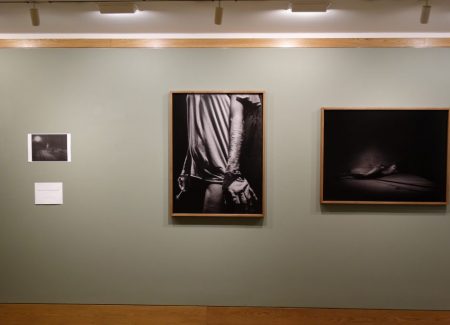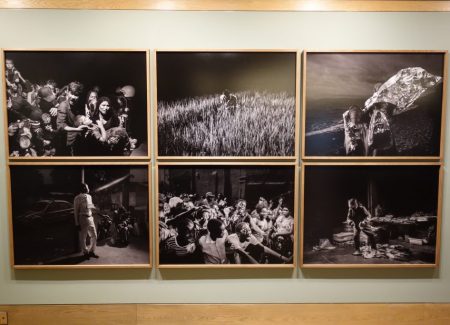JTF (just the facts): A total of 16 black and white photographs, framed in wood and unmatted, and hung against light green walls in the main gallery space and the book alcove. All of the works are archival pigment prints, made between 2011 and 2016. Each image is sized roughly 35×47 (or reverse) and is available in editions of 5+3AP. The show also includes a wall display of test prints and archival imagery. (Installation shots below.)
Comments/Context: The first thing you notice about Alex Majoli’s photographs is the unexpected way they use light. His images seem to drown in the rich, velvety, enveloping darkness of night, that is until you realize that the pictures were made with a flash of bright strobe that highlights the central figures and allows the rest of the surroundings to recede to black. This discovery leaves us with a surprising inversion – these deeply dark pictures were actually made during the day, so we have to recalibrate our understanding of what exactly they show us.
That Alex Majoli is a long time documentary photographer, Magnum Photos member, and 2016 Guggenheim Fellowship winner, who has spent time in Afghanistan and Iraq and made bodies of work in Greece, France, and plenty of other far off locales, makes this carefully managed use of light even more unusual – it’s not the kind of artistic license we expect to see applied to the violence and suffering of the news headlines. So it raises open questions about what exactly we’re seeing – it likely takes a bit of work to set up such an alternative lighting effect (and perhaps an assistant or two), and so the people in his pictures have to have at least tangentially understood that they were being photographed. So is what we’re seeing documentary “reality” or something akin to a theatrically staged performance, albeit in the context of real world events?
Majoli’s light both amplifies and reduces his images, in effect paring them down to the essential emotions that are portrayed there. His densely composed scenes of crowds and gatherings of people benefit most from this chiaroscuro, using a version of the same techniques that made Rembrandt’s interiors and portraits so moody and charged with tension. In Egypt and Greece, expectant faces catch the light, with tangles of arms and shoulders giving the darkness texture and depth. And when Majoli turns his camera to the chaos of street protests (in Greece and Congo), the light stops the action with surreal energy, with sobbing faces, shouting crowds, and cradled children turning into frozen tableaux, in poses that recall the controlled interaction of Old Masters scenes or Madonna and child religious paintings.
When Majoli uses his light to single out a lone figure or pair, the results are sythesized, more akin to a small spotlight placed on a Broadway star alone on stage. We watch a woman carrying a machete, a suited man striding near train tracks, a woman selling fish in a Chinese market, an Indian man wading through a sea of rice, and a pair of weeping refuges on the beach, their silvery relief-issued blanket blown by a strong gust of wind. In each case, the scene feels pregnant and the light directs our attention, as though the subject is just about to break the fourth wall and address us directly with his or her reflective story.
What Majoli is doing is using light (or darkness) to strip away the distractions that would normally keep us from seeing the essence of the circumstances, and that deliberate reduction in surrounding context and information forces us to pay closer attention to the central action. His travels have put him face to face with a spectrum of everyday agonies, and he has made pictures that embellish their inherent theatricality, with a eye for painterly composition. In exaggerating the play of light to the point that it becomes an enchantment, Majoli’s photographs revel in the theater of the streets, casting his subjects in the struggles of their own lives. The best of his images use this momentary intensity to create transporting scenes that feel untethered to the usual restrictions of time.
Collector’s POV: The prints in this show are priced at $10500 each. Majoli’s work has little secondary market history, so gallery retail likely remains the best option for those collectors interested in following up.
